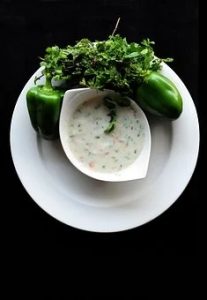The cooler weather of autumn brings more than shorter days and warmer clothes. Fall is perfect soup weather and–who knew?!–souping is an effective weight loss strategy. While not everyone believes that soup is a meal, the truth of the matter is that it depends on the soup. Turns out, souping can be a healthy, effective way to tweak your diet and you might be surprised at how satisfied you feel after a bowl full of goodness.
Souping Concept
Many soups are low-cal AND they’re packed with nutrition and help keep you hydrated, too. The fact is, soup is soup-erior (yes, pun totally intended; sorry/not sorry) to juicing as a way to cleanse the body, increase energy, and kick-start fat loss. While juicing leaves substantial mounds of fiber in your juicer’s waste container, soup utilizes whole vegetables and sometimes fruits, and that includes the fiber content. Since fiber is typically digested slowly, that means a bowl of fiber-filled soup will keep you feeling fuller, longer than a smoothie. Soups are usually filled with healthy veggies, too, so it’s a terrific way to eat better on top of feeling more satisfied while eating less. Your budget gets a bonus from souping, as well: it’s less expensive to cook up a big pot of soup that will feed you for several meals than it is to buy all the produce you need for one smoothie, according to Yoga Journal.
The Fiber Issue Is More Important Than You Think
Ditching the fiber when you juice doesn’t only sabotage hunger control. It essentially turns a healthy piece of fruit into the enemy. As Forbes points out, the fiber in whole fruit helps your body release the sugar from the fruit into your bloodstream at a slow pace that’s easy to handle, so your pancreas doesn’t go into insulin overload. Gulp down the juice from about three oranges or apples (an average number to produce one glass of juice), and all that sugar, natural though it may be, gets dumped into your system, forcing your body to kick out more insulin. You might as well go on an all-soda diet if your grand scheme to lose weight centers on juicing.
Don’t View It As a Cleanse

Soup for lunch will get you through the day as well as reduce your overall caloric intake and help you eat healthier.
“Cleanses” sound ultra-healthy, but they’re intended to be short-term and not lifestyle-defining. You have to be realistic and understand that, regardless of whether you opt for juicing or souping or something entirely different, it’s not intended to be a lasting change. You’re supposed to do it for a day or two as a reset, then move on to the next phase of your diet. The thing about souping, however, is that it can be one of those small changes you make for the long haul. Instead of eating soup for every meal, use it as a meal replacement for one meal a day–lunch, for instance. Even when you bookend your soup lunch with a full (but reasonable and healthy!) breakfast and dinner, you’ll be eating fewer calories overall and eating healthier, more wholesome foods and that’s how you get on the right track to lasting weight loss. Think you’ll get bored with soup every day? Not likely when you have a variety of recipes to choose from. Start your collection with satisfying, delicious soups from Men’s Health and Yoga Journal.
Souping Tips

Decadent, creamy soups get a reduction in fat and calories and a nutritional boost from healthy cream alternatives.
Healthy Women reminds readers that not all soups are healthy simply by virtue of being soup. Decadent, creamy soups are usually jam-packed with fat which kicks up the calorie count. That doesn’t mean you have to avoid cream-based soups; you just have to be creative when cooking them. For example, a head of cooked cauliflower that’s been pureed is a tasty way to create a thick and creamy texture in soup without using cream, and the cauliflower will increase the nutrition of the soup at the same time. Pureed navy beans are another healthful alternative to adding cream to soup, one that increases the protein content as well as the fiber content.
And speaking of protein, one of the best things about a good, hearty soup that fills you up is the chunks of lean meat in it. What’s more, you can customize practically any soup recipe to make it vegetarian or pack it with protein from sliced or shredded chicken breast, cubes of steak, or delicate flakes of fish.


